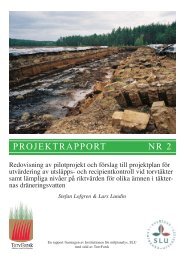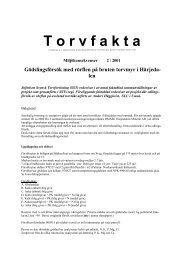PROJEKTRAPPORT NR 3 - Stiftelsen Svensk Torvforskning
PROJEKTRAPPORT NR 3 - Stiftelsen Svensk Torvforskning
PROJEKTRAPPORT NR 3 - Stiftelsen Svensk Torvforskning
Create successful ePaper yourself
Turn your PDF publications into a flip-book with our unique Google optimized e-Paper software.
Summary<br />
There are a number of land-use alternatives for cutover peat areas after finished peat cutting.<br />
One land-use alternative is afforestation. In this investigation it was studied how drainage, soil<br />
treatments including fertilization, and plantation affected the carbon storage 20 years later.<br />
The studied area is located on the mire Flakmossen in the county of Värmland, SW Sweden.<br />
Peat was harvested on 34 hectare of this mire up to 1945. The major part of the cutover area<br />
was abandoned until 1982 when after-use activities started. The depth of the remaining peat<br />
varied between a few decimeters up to about two meters. Prior to any soil measures, determination<br />
of peatland conditions was carried out. Important to this investigation was, a priori, the<br />
carbon store, i.e. remaining peat thickness was crucial. Therefore, peat depth was thoroughly<br />
investigated on 14 hectares of the cutover area in summer 1983. The remaining peat was also<br />
sampled at different depths within 18 plots of the whole cutover peat area. These samples<br />
were analyzed on i.a. concentrations of carbon and nitrogen. As bulk density also was determined,<br />
the amounts of carbon and nitrogen in the remaining peat could be estimated. A very<br />
good correlation was found between peat depth and the carbon pool in the peat.<br />
After-use activities included two afforestation projects that in the beginning of the 1980’s<br />
were set up on the abandoned peat cutover area. One project was a conventional pine plantation<br />
on 19 hectares, where the effects of different drain spacings and PK-fertilizer doses were<br />
studied. The other project was an intensively managed forest experiment carried out on 14<br />
hectares. This area was first drained and then fertilized with on average 23 tonnes of wood fly<br />
ash, 0.4 tonnes of raw phosphate and 0.25 tonnes of superphosphate per hectares. The applied<br />
fertilizers and the uppermost 30-40 cm of the peat were then mixed by a tractor-drawn rotovator<br />
in one meter wide strips. In these strips, on the 97 established plots, six different tree species<br />
were planted.<br />
In autumn 2003, twenty years after the establishment of the intensively managed forest experiment,<br />
peat depth was measured in totally 49 plots on the two afforestation experimental<br />
areas. Peat was sampled from up to 6 depths on 30 plots and analyzed on bulk density, and<br />
concentrations of carbon and nitrogen. On 48 plots the tree biomass were estimated by measurement<br />
of breast height diameter on trees within ca 100 m 2 sample plots. The carbon concentration<br />
in the tree biomass was assumed to be 50 % of dry weight, while nitrogen concentration<br />
was assumed to vary between 0.2 and 0.8 % of dry weight, depending on tree compartment<br />
and tree species.<br />
At the intense cultivation area, the peat depth was on average 8 cm smaller in autumn 2003<br />
compared to the depth in summer 1983. If the humus layer with an accumulation of on average<br />
4.6 cm during the 20 years until autumn 2003 would be included, the depth of organic<br />
material was only 3 cm smaller in 2003. The carbon pool in the peat had decreased by on average<br />
2.4 kg C m -2 . With the humus layer included the decrease was only 0.5 kg C m -2 . The<br />
total tree biomass (above and under ground) contained on average 5.4 kg C m -2 . During the 20<br />
years, since the establishment of the intense cultivation area, the total carbon pool (soil +<br />
biomass) had increased with, on average, 10 % or 4.9 kg C m -2 . However, the variation was<br />
large between the plots within this area. Some plots showed a negative carbon balance, but<br />
most plots showed a net accumulation of carbon during these 20 years. The values for the<br />
8




